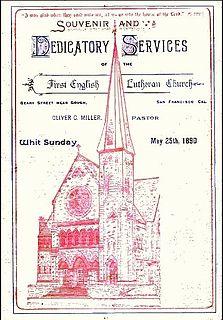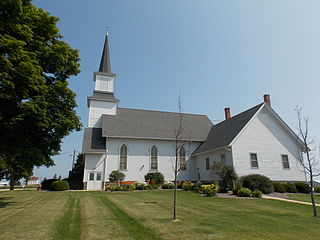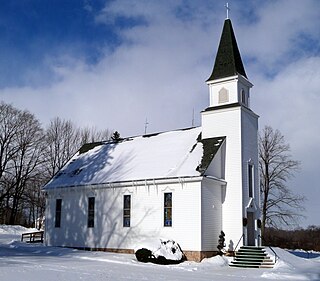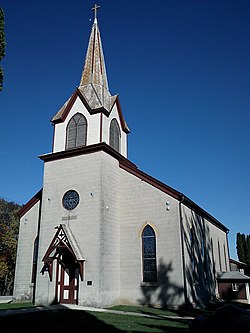
The Lutheran Church—Missouri Synod (LCMS), also known as the Missouri Synod, is a traditional, confessional Lutheran denomination in the United States. With slightly under 2 million members, it is the second-largest Lutheran body in the United States. The LCMS was organized in 1847 at a meeting in Chicago, Illinois, as the German Evangelical Lutheran Synod of Missouri, Ohio, and Other States, a name which partially reflected the geographic locations of the founding congregations.

The Evangelical Lutheran Synodical Conference of North America, often known simply as the Synodical Conference, was an association of Lutheran synods that professed a complete adherence to the Lutheran Confessions and doctrinal unity with each other. Founded in 1872, its membership fluctuated as various synods joined and left it. Due to doctrinal disagreements with the Lutheran Church–Missouri Synod (LCMS), the Evangelical Lutheran Synod (ELS) and the Wisconsin Evangelical Lutheran Synod (WELS) left the conference in 1963. It was dissolved in 1967 and the other remaining member, the Synod of Evangelical Lutheran Churches, merged into the LCMS in 1971.

Christ Evangelical Lutheran Church is a historic church built in 1901 by a German Lutheran congregation southwest of the Walker's Point neighborhood of Milwaukee, Wisconsin. It is listed on the National Register of Historic Places.

St. John's Evangelical Lutheran Church is a Gothic Revival-styled church built in 1889 in Milwaukee, Wisconsin by a congregation with German roots. In 1992, the church and associated buildings were listed on the National Register of Historic Places. It is also designated a Milwaukee Landmark.

St. Peter's Evangelical Lutheran Church, or Iglesia Luterana San Pedro, is a historic church complex located in the Walker's Point neighborhood of Milwaukee, Wisconsin. Its buildings are listed on the National Register of Historic Places.

St. Olaf Kirke, commonly referred to as The Rock Church, is a small Lutheran church located outside of Cranfills Gap, Texas, United States, in an unincorporated rural community known as Norse in Bosque County, Texas. The Church is affiliated with the Evangelical Lutheran Church in America.

First United Lutheran Church is a congregation of the Evangelical Lutheran Church in America (ELCA), located in San Francisco, California. Formed in 1886, it was the first Lutheran congregation in California to use English as its primary language for worship. In 1990, First United was suspended, and later expelled from the ELCA for ordaining an openly gay pastor, against the wishes of the denomination. The ELCA Churchwide Assembly voted to approve openly gay clergy in 2009, and in 2012, First United rejoined the denomination. Presently a "church without walls," First United meets in St. Cyprian's Episcopal Church, located at 2097 Turk Street, near the main campus of the University of San Francisco.

St. Paul Lutheran Church is located in central, Davenport, Iowa, United States. It is affiliated with the Evangelical Lutheran Church in America (ELCA). The church's original property, which subsequently housed other Protestant congregations, was listed on the National Register of Historic Places in 1983, but has since been torn down. The present complex was built in 1952 and contains two buildings that are contributing properties in the Vander Veer Park Historic District. The present church building was completed in 2007.
The Evangelical Lutheran Joint Synod of Ohio and Other States, commonly known as the Joint Synod of Ohio or the Ohio Synod, was a German-language Lutheran denomination whose congregations were originally located primarily in the U.S. state of Ohio, later expanding to most parts of the United States. The synod was formed on September 14, 1818, and adopted the name Evangelical Lutheran Joint Synod of Ohio and Other States by about 1850. It used that name or slight variants until it merged with the Iowa Synod and the Buffalo Synod in 1930 to form the first American Lutheran Church (ALC), 1930–1960.

Augustana Lutheran Church is an Evangelical Lutheran Church in America congregation located in Sioux City, Iowa, United States. The church building was listed on the National Register of Historic Places in 2006 as Swedish Evangelical Lutheran Augustana Church.

Our Savior's Kvindherred Lutheran Church is an Evangelical Lutheran Church in America congregation located near the town of Calamus in rural Clinton County, Iowa, United States. The church and former school buildings as well as the church cemetery were listed as an historic district on the National Register of Historic Places in 2000.

The Leer Lutheran Church, also known as the Norwegian Lutheran Church is a church located at 10430 South Leer Road, near Leer in Long Rapids Township, Michigan. The church grounds include a parish house, cemetery, and pavilion, as well as the church itself. The church is substantially the same as when it was built. Highlights include an altar painting by Sarah Kirkeberg Raugland, and an unusual pressed metal interior in the parish house. It was listed on the National Register of Historic Places in 2013.

Grace Lutheran Church in Uniontown, Missouri is a member congregation of the Lutheran Church–Missouri Synod (LCMS).

Trinity Lutheran Church is a member congregation of the Lutheran Church–Missouri Synod (LCMS) in Altenburg, Missouri.

Hebron Church is a mid-19th-century Lutheran church in Intermont, Hampshire County, in the U.S. state of West Virginia. Hebron Church was founded in 1786 by German settlers in the Cacapon River Valley, making it the first Lutheran church west of the Shenandoah Valley. The congregation worshiped in a log church, which initially served both Lutheran and Reformed denominations. Its congregation was originally German-speaking; the church's documents and religious services were in German until 1821, when records and sermons transitioned to English.

Mount Pisgah Lutheran Church, also known in its early years as the First Lutheran Church and First English Lutheran Church and more recently as The Sanctuary on Penn, is located at 701 North Pennsylvania Street in downtown Indianapolis, Indiana. The historic church was built by the city's first Lutheran congregation, which organized in 1837, and was its third house of worship. The former church, whose present-day name is The Sanctuary on Penn, is operated as a for-profit event venue.

Waterloo Ridge Lutheran Church is located northwest of the unincorporated community of Dorchester, Iowa, United States. It and the churchyard form a nationally recognized historic district that was listed on the National Register of Historic Places in 2015. At the time of its nomination, it consisted of three resources, which included one contributing building, one contributing site, and one contributing structure.

West Paint Creek Synod Evangelical Lutheran Church and Cemetery is a historic building and site located northwest of Waterville, Iowa, United States. The church building and its adjacent cemetery were listed together on the National Register of Historic Places in 2019.

The Lutheran Church of the Redeemer is a Lutheran church in midtown Atlanta, Georgia. The congregation was founded in the city in 1903, with the current building constructed in 1952.

Christ Lutheran Church on Capitol Hill is a congregation of the Evangelical Lutheran Church in America (ELCA) in the Thomas-Dale neighborhood of Saint Paul, Minnesota, United States.





















